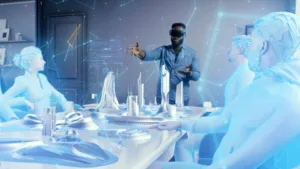In the consistently developing domain of visual innovation, Hologram Projector stands as quite possibly one of the most charming and promising advancements. These gadgets, when thought about the stuff of sci-fi, have now risen above the limits of the creative mind to turn into a substantial reality. As we dig into the universe of Hologram Projectors, we will disentangle their inward activities, investigate their applications, gauge the upsides and downsides, and briefly look into the future they guarantee.

Envision a reality where three-layered, exact pictures emerge in dainty air, apparently opposing the laws of physical science. This is exactly the charming domain that visualization projectors usher us into. 3D images, when thought about as a modern idea, are currently a piece of our contemporary visual scene, promising invigorating conceivable outcomes across different spaces.
How Hologram Projector Works:
Hologram Projector work on the guideline of diffraction, where light waves cooperate with complicated examples to make the deception of three-layered objects. Here is a worked-on breakdown of their activity:
Light Source:
Hologram projectors normally use lasers as their light source, giving a cognizant light emission.
Pillar Splitter:
The laser bar is parted into two ways, with one section guided at the item to be recorded and the other coordinated at a reference shaft.
Recording Plate:
The item bar communicates with the item and strikes a recording plate, while the reference shaft strikes a similar plate at an alternate point.
Obstruction Pattern:
The two pillars make an impedance design on the recording plate, encoding the article’s data.
Reconstruction:
However to see the hologram, a laser pillar like the reference bar is coordinated onto the holographic plate. The impedance design remakes the hologram in space, making the holographic deception.

Applications of Hologram Projectors:
Hologram projectors have risen above curiosity to track down commonsense applications across different ventures:
Entertainment: Holographic shows and dramatic exhibitions offer a strange and vivid experience for crowds.
Medicine: Clinical experts utilize holographic imaging for careful preparation and preparation, empowering exact strategies.
Education: Visualizations improve advancing by rejuvenating complex ideas in science, and history, and that’s just the beginning.
Marketing: Retailers utilize holographic presentations to enthrall clients and advance items.
Telecommunications: Holographic video conferencing holds the possibility to reform distant correspondence.
Advantages and disadvantages of Hologram Projector:
How about we gauge the pros and cons of Hologram Projectors:
Pros |
Cons |
|---|---|
| Vivid Experience: Holograms offer an unrivaled vivid encounter, charming crowds more than ever.
|
Cost: Great hologram projectors can be costly, restricting inescapable reception.
|
| Clinical Advancements: In medication, holographic imaging supports diagnostics, medical procedures, and schooling, possibly saving lives.
|
Complexity: Making and projecting visualizations requires particular hardware and skill.
|
| Instructive Tool: Visualizations advance schooling by picturing complex subjects and upgrading understanding.
|
Restricted Survey Angle: A few 3D images have confined review points, ruining their openness.
|
| Unending Creativity: Visualization projectors open vast opportunities for imagination in craftsmanship, planning, and amusement.
|
Energy Consumption: Strong lasers utilized in holography can consume significant energy.
|
The Future of Hologram Projector:
The development of Hologram Projector’s guarantees a future loaded up with development:
More modest and Portable: Headways expects to make visualization projectors more minimal and compact, however carrying holographic encounters to our day-to-day routines.
Upgraded Realism: Progressing research looks to work on the authenticity of visualizations, making them much more undefined from the real world.
Incorporation with AR/VR: Hologram projectors might converge with increased reality (AR) and computer-generated reality (VR) innovations, meanwhile making consistent blended reality encounters.
Clinical Breakthroughs: Holographic clinical imaging is ready to upset diagnostics and medical procedures, possibly saving more lives.

FAQ’s:
Do hologram projectors work?
Indeed, 3D image projectors take care of business. Moreover, they make three-layered pictures utilizing the guideline of diffraction and laser innovation, making similar holographic deceptions that can be seen from various points, giving a vivid visual encounter.
How to make a real hologram at home?
Making a genuine visualization at home ordinarily requires particular gear and is a perplexing interaction. Be that as it may, worked-on holographic units are accessible, permitting you to make fundamental multi-dimensional images by recording an article on a photosensitive plate and enlightening it with a laser for a 3D impact.
How much is a hologram of yourself?
The expense of making a visualization of yourself can shift fundamentally contingent upon the intricacy and quality wanted. Fundamental 3D images may be created for a couple of hundred bucks, while top-caliber, similar visualizations can cost a few thousand bucks or more, particularly in the event that you need proficient support and concentrated hardware.
What is the best hologram projector?
The best 3D image projector relies upon your particular requirements and financial plan. A few well-known choices incorporate the Looking Glass Portrait, Holho 4 Faces Pyramid, and Sony Spatial Reality Display. Research and pick one that lines up with your expected applications, whether it’s for diversion, instruction, or expert use.
Conclusion:
Hologram Projectors are more than simple devices; they are doors to a future where our visual encounters rise above the limits of screens and aspects. These gadgets have tracked down applications in amusement, training, medication, and then some, encouraging to reform in these fields.
All in all, the excursion of the Hologram Projector is one that entices us to investigate the unfamiliar domains of visual innovation. However as we open their true capacity, the limits of what we see as reality keep on extending, promising a future where multi-dimensional images become a necessary piece of our lives.
